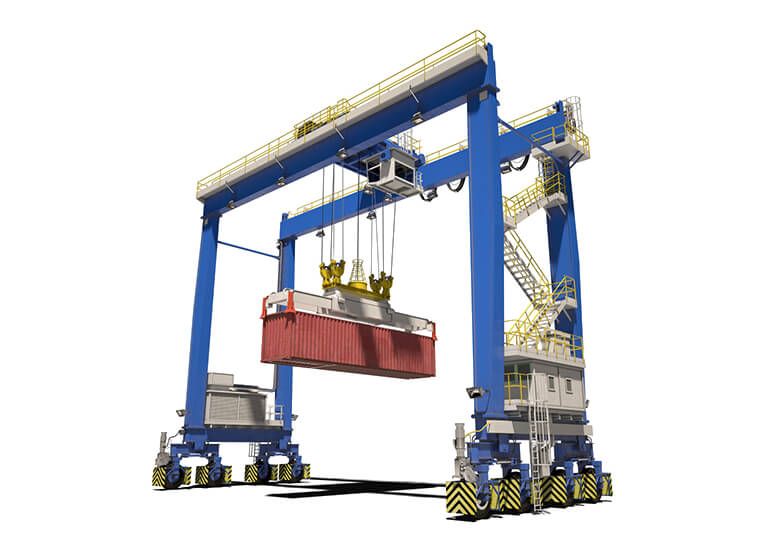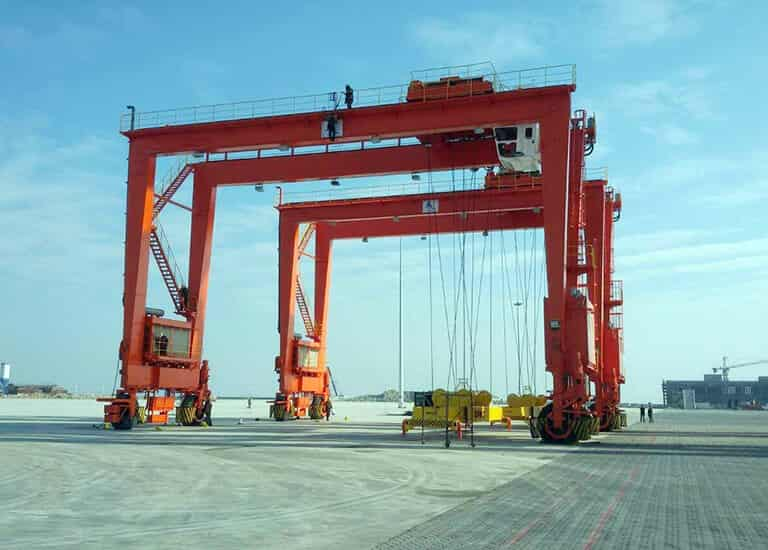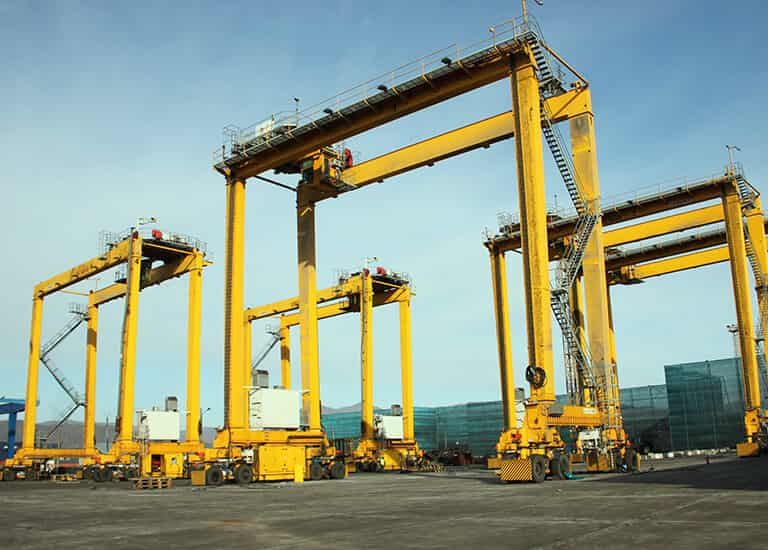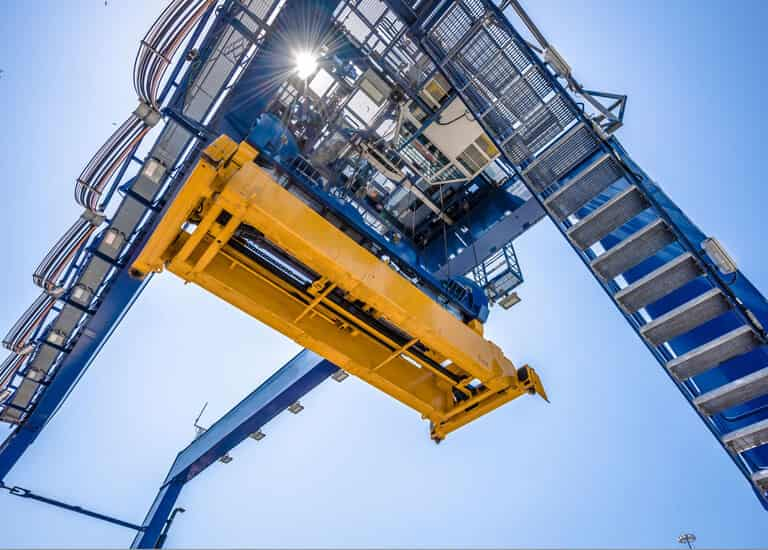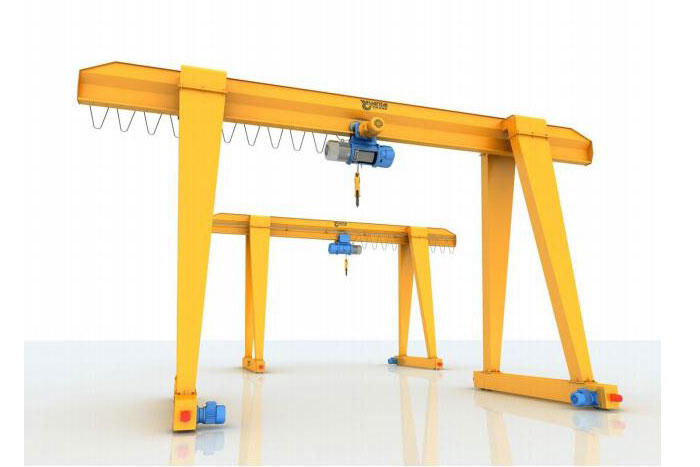Ton Gantry Crane & Price
Rubber Tyred (RTG) Gantry Crane Price
Lifting Capacity: 20~45 ton
Span: 12~18 m
Lifting Height: m
Working Class: A6
Note: We can design and manufacture the crane according your requirments and working conditions.
Rubber tyred gantry (RTG) crane is a type of mobile gantry crane commonly used in container handling at ports and container yards. Unlike traditional rail-mounted gantry cranes (RMG), Rubber tyred gantry crane are mounted on rubber tires, which allows RTG crane to move around the container storage area more flexibly and without the need for fixed rail tracks.
RTG crane are a common sight in container terminals worldwide, where they play a vital role in the efficient handling of containers, ensuring they are loaded, unloaded, and stacked appropriately. RTG crane mobility and versatility make them a popular choice for many container handling operations.
Rubber tyred gantry crane technical specification:
| Capacity Of Spreader | T | 30.5 | 35 | 40.5 | ||
|---|---|---|---|---|---|---|
| Working Duty | A6 | A6 | A6 | |||
| Span(M) | S | 23.47 | 23.47 | 23.47 | ||
| Base(M) | B | 7.4 | 7.4 | 7.5 | ||
| Lifting Height(M) | H | 15.4 | 15.4 | 18.2 | ||
| Speed | Hoisting | With Full Load | M/Min | 12 | 12 | 23 |
| Only With Spreader | 24 | 24 | 46 | |||
| Traverse | 70 | 70 | 70 | |||
| Travailing | With Full Load | 45 | 45 | 45 | ||
| Only With Spreader | 90 | 90 | 90 | |||
| Main Dimensions | L | 25370 | 25370 | 25395 | ||
| H1 | 22030 | 22334 | 25134 | |||
| L1 | 905 | 905 | 905 | |||
| L2 | 950 | 950 | 975 | |||
| Total Power Of Diesel Motor | kW | ~305 | ~305 | ~400 | ||
| Total Power Of Generator | kVA | ~518 | ~595 | ~720 | ||
| Max. Working Load Of Wheel | kN | 273 | 287 | 320 | ||
Container Spreaders for RTG Cranes

| Container Model | 20' Container | 40' Container | |
| Lifting capacity | 32 ton | 40.5 ton | |
| Rotation speed | 0-1.5 r/min | 0-1.5 r/min | |
| Power supply | AC 380/3/50 | AC 380/3/50 | |
| Size(mm) | L | 5853 | 11985 |
| S | 2260 | 2260 | |
| A | 6056 | 12188 | |
| B | 2436 | 2436 | |
| H | 3620 | 3887 | |

| Container Model | 20' 40' 45' Container | |
| Lifting capacity | 40.5 ton (under spreader) | |
| Rotation speed | 0-1.5 r/min | |
| Rotation time | 1.5S | |
| Telescopic action time | 40S | |
| Hydraulic system | 10MPa | |
| Power supply | AC 380/3/50 | |
| Self-weight | 12 ton | |
| Size(mm) | L | 5853-11985-13510 |
| S | 2260 | |
| A | 6053-12185-13710 | |
| B | 2436 | |
| A1 | 5000 | |
| B1 | 1200 | |
| H | 3620 | |
The factors that influence RTG crane price:
- Capacity: The lifting capacity of the RTG crane is a major determinant of RTG crane price. Cranes with higher lifting capacities typically come with a higher price tag.
- Manufacturer: Different manufacturers offer RTG crane with varying quality, technology, and brand recognition. Established and well-known manufacturers often command higher prices.
- Specifications: The specific features and capabilities of the RTG crane, such as automation and safety systems, can affect the cost. More advanced and feature-rich cranes will generally be more expensive.
- Customization: If the RTG crane needs to be customized to meet unique requirements, such as non-standard lifting heights or additional features, the rubber tyred gantry crane price will be higher to accommodate these modifications.
- Optional Accessories: Additional equipment and accessories, such as spreaders and remote control systems, can add to the overall RTG crane price.
- Environmental Considerations: RTG crane with environmentally friendly power options, such as electric or battery-powered models, might have a higher upfront cost but can result in long-term savings and lower operating expenses.
RTG crane price:
- Small to Medium Capacity RTG Crane: RTG crane with a lifting capacity of around 20-40 tons might typically fall in the range of approximately $100,000 to $400,000 or more, depending on specifications and features.
- Medium to Large Capacity RTG Crane: For RTG crane with lifting capacities of 40-60 tons or more, the RTG crane price range can extend from approximately $400,000 to $1.5 million or higher.
| Rubber-Tired Gantry Crane (RTG)(t) | Span(m) | Lifting Height(m) | Power Supply(V) | Price(USD) |
| 30 ton RTG crane | 20~30 | 12~18 | 220-480/3/50 | $150,000 - $300,000 |
| 35 ton RTG crane | 20~30 | 12~18 | 220-480/3/50 | $180,000 - $350,000 |
| 40 ton RTG crane | 20~30 | 12~18 | 220-480/3/50 | $200,000 - $400,000 |
Please note that these are rough estimates, and RTG crane prices can vary significantly based on the factors mentioned. The actual rubber tyred gantry crane price will depend on the crane's specifications, manufacturer, location, and any additional features or accessories required. To get an accurate RTG crane price quote, it's advisable to contact RTG crane manufacturers or suppliers and provide them with your specific requirements.
RTG crane advantage and benefit:
- Mobility: RTG crane are mounted on rubber tires, giving them the ability to move independently across a paved or concrete surface. This mobility allows for flexible and efficient container handling without the need for fixed rail tracks, making them well-suited for container yards with varying layouts.
- Versatility: RTG crane can handle a wide range of container sizes and types, making them adaptable to different container handling requirements in container terminals.
- High Productivity: RTG crane are known for their speed and efficiency in moving and stacking containers. They can quickly maneuver between containers, lift them, and place them precisely in the desired location.
- Flexible Stacking: RTG crane can stack containers in multiple rows and levels, optimizing the use of storage space in container yards.
- Reduced Infrastructure Costs: Since they do not require fixed rail tracks, RTG crane can help reduce the infrastructure investment needed in container yards, making them a cost-effective choice for port operators.
- Environmentally Friendly: Electric-powered RTG crane produce fewer emissions compared to diesel-powered alternatives, contributing to a more environmentally friendly operation.
- Safety Features: RTG crane are equipped with safety features such as anti-collision systems, load monitoring, and emergency stop controls to ensure safe operations and protect workers and cargo.
- Automation and Remote Control: Modern RTG crane can be equipped with automation and remote control capabilities, allowing for efficient, precise, and remote operation, which can further enhance productivity and safety.
Rubber tyre gantry crane power options:
- Electric Power: Electric-powered RTG crane are common and considered more environmentally friendly. They are typically connected to an external electrical grid through overhead power lines, which supply the necessary electricity for crane operation. Electric RTG crane offer low emissions, reduced noise levels, and are easy to control.
- Diesel Power: Some RTG crane are equipped with diesel generators to generate their own power. This is particularly useful in locations where a reliable electrical supply is not available or when a high degree of mobility is required. Diesel-powered RTG crane can move more freely within the terminal, as they are not constrained by fixed power sources. However, they produce emissions and are generally less environmentally friendly than electric options.
- Hybrid Power: Hybrid RTG crane combine both electric and diesel power sources. They can operate on electric power when connected to the grid and switch to diesel power when they need to move to areas without access to electrical infrastructure. This flexibility allows them to balance environmental concerns with operational demands.
The choice of power source for RTG crane depends on factors such as the terminal's location, environmental regulations, operational requirements, and the cost of fuel or electricity. Many modern terminals are moving toward electric or hybrid RTG crane to reduce emissions and minimize their environmental footprint. However, diesel-powered RTG crane remain in use, especially in areas where electricity infrastructure is limited or where high mobility is a priority.
Previous:10 Ton Gantry Crane Price

